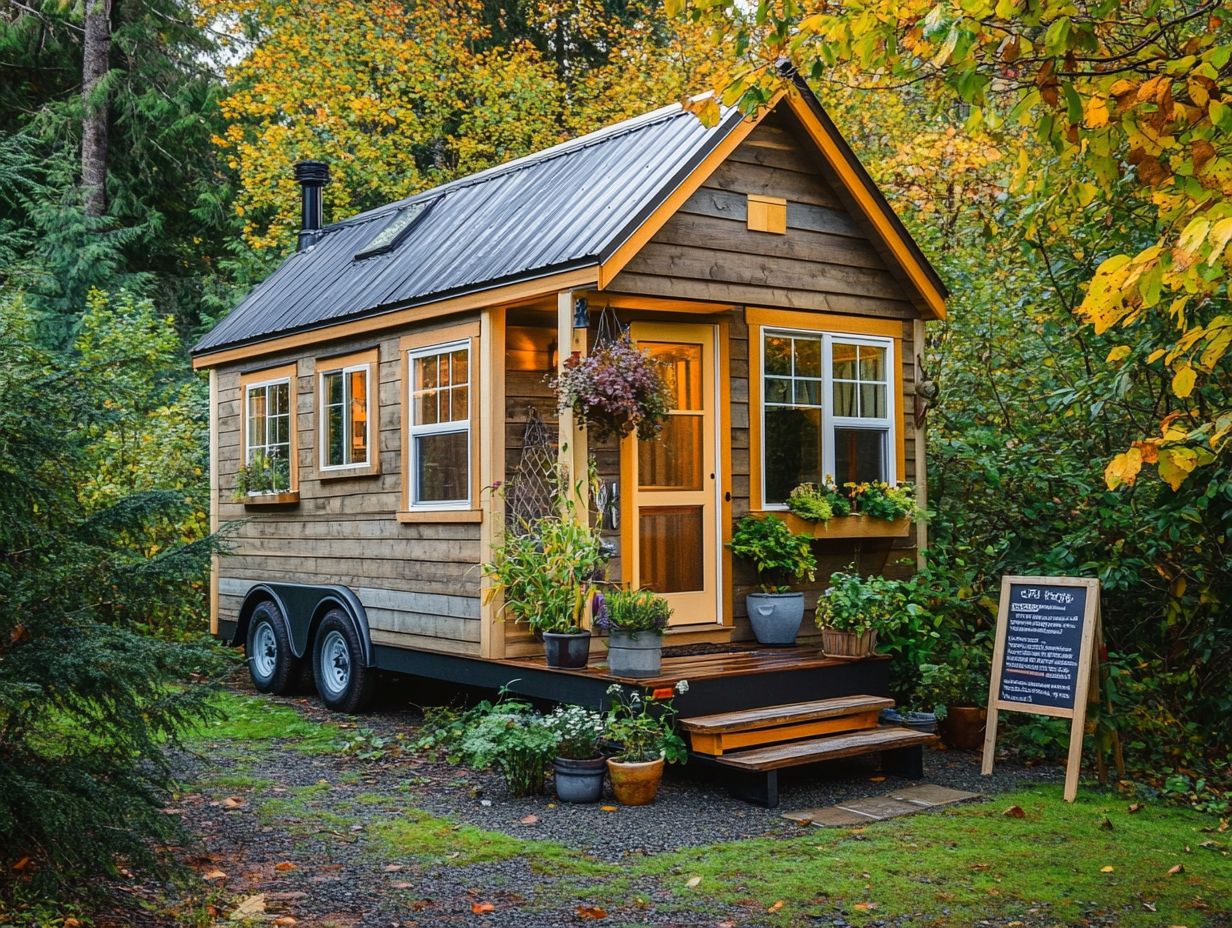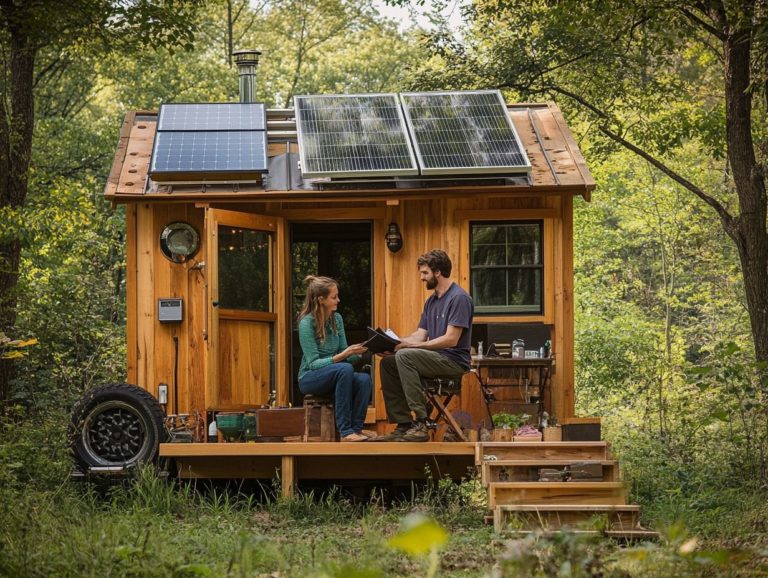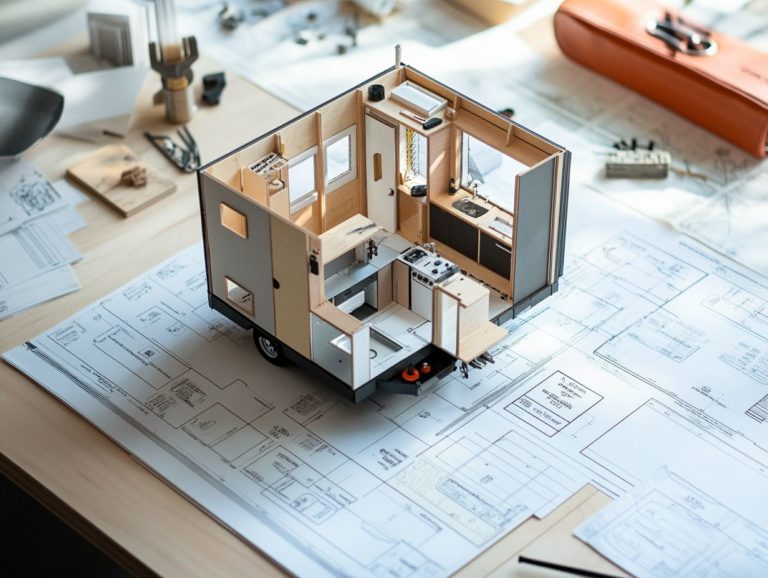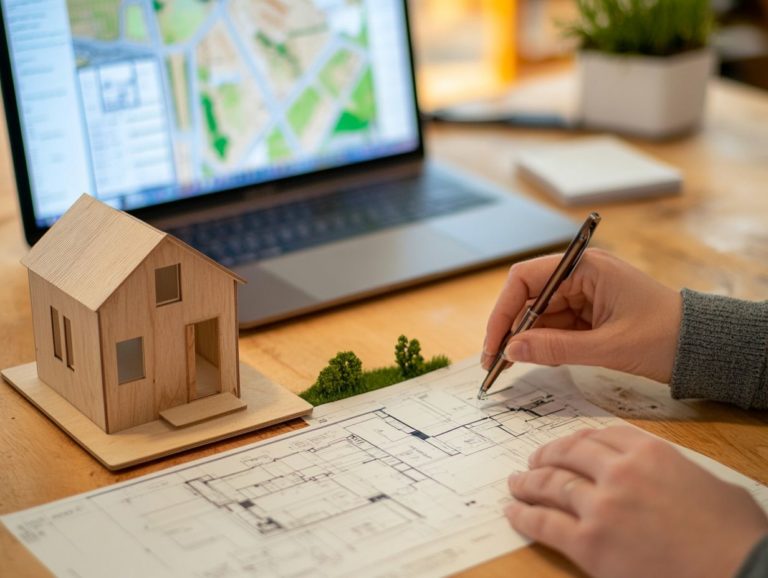Tiny House Law: Key Elements Every Owner Should Know
Tiny houses represent more than a fleeting trend; they embody a lifestyle choice that many individuals embrace for the virtues of simplicity and sustainability.
Navigating the legal landscape surrounding tiny homes can be intricate. From zoning and building codes to land ownership and utility options, grasping these regulations becomes essential for anyone contemplating this minimalist way of life.
This article delves into the critical laws and considerations that every aspiring tiny house owner should familiarize themselves with, ensuring that your foray into tiny living is both fulfilling and compliant.
Contents [hide]
- Key Takeaways:
- Your Guide to Tiny House Laws
- Zoning and Building Codes
- Land Ownership and Parking
- Utilities and Off-Grid Living
- Frequently Asked Questions
- What is considered a tiny house under the law?
- Do I need a building permit to build a tiny house?
- Can I legally live in a tiny house full-time?
- What are the zoning and land use regulations for tiny houses?
- Are there any safety regulations for tiny houses?
- What are the insurance considerations for a tiny house?
Key Takeaways:

- Tiny houses come with unique regulations because of their small size.
- Zoning laws are key they determine where you can place your tiny home.
- Explore your land ownership options: buying, renting, or joining a community land trust.
Your Guide to Tiny House Laws
Getting to know tiny house laws is your ticket to a simpler and more fulfilling life! These regulations dictate the locations and methods for building or placing tiny houses.
The Tiny House Movement has gained considerable traction, inspiring many to adopt a minimalist lifestyle. However, the intricate landscape of tiny house laws can present challenges. Local building codes and zoning regulations can differ significantly, especially when weighing options between tiny houses on wheels and those anchored to a foundation.
Accessory dwelling units (ADUs) add another layer of complexity to tiny house living.
What are Tiny Houses and Why are They Regulated?
Tiny houses are wonderfully compact living spaces, typically ranging from 100 to 400 square feet. They’ve gained traction through the Tiny House Movement, which champions simpler living and a reduced environmental impact.
This movement resonates with those who seek to downsize their lifestyles, minimize ecological footprints, and prioritize experiences over material possessions. The allure of tiny houses extends beyond their economic benefits; they also cultivate a sense of community and sustainability. However, it’s important to understand the legal aspects as well, including tiny house licensing. Advocates argue that residing in such modest spaces fosters a mindful existence and encourages deeper personal connections.
The rise of tiny houses has prompted crucial regulations that tackle safety concerns, zoning laws, and community standards. To navigate these complexities, it’s important to be aware of tiny house legal resources you should know. These measures help tiny houses thrive in neighborhoods while adhering to building codes designed to protect residents.
Zoning and Building Codes
Zoning and building codes are pivotal in determining the placement and construction of tiny houses, significantly impacting their legality across different states in the U.S. Understanding these regulations is essential for anyone considering a tiny home, as they dictate not only where these homes can be situated but also how they must be built.
How Zoning Laws Affect Tiny House Living

Zoning laws play a crucial role in tiny house living, determining where these compact homes can be located. Specific permits and adherence to local zoning regulations are essential.
In states like New York, zoning regulations can be quite restrictive. You may encounter limitations that confine tiny houses to designated areas or impose strict building codes, which can impede the growth of thriving tiny house communities. For those seeking guidance, understanding tiny house occupancy permits is crucial. In contrast, Texas offers a more welcoming environment with its permissive zoning laws. Here, you’ll find greater flexibility in placement options, making it easier for those looking to embrace a minimalist lifestyle.
These discrepancies highlight how zoning not only shapes the availability of housing but also profoundly influences the accessibility of tiny living. Ultimately, this affects the broader movement toward sustainable and affordable living options that many aspire to achieve.
Ready to take the plunge into tiny living? Let s explore your options!
Building Codes and Safety Requirements
Building codes and safety requirements for tiny houses are crucial for ensuring structural integrity and occupant safety. They cover vital aspects like minimum ceiling height and emergency exit points.
These regulations shape the overall design and address plumbing, electrical systems, and energy efficiency standards. Tiny houses on wheels often follow different rules than those anchored to a foundation. While the latter typically adheres to local building codes for conventional homes, the former may fall under RV laws, impacting sanitation and safety standards. For a comprehensive overview, check out the tiny house regulations: a state-by-state guide.
This discrepancy requires careful consideration of local ordinances and inspection protocols. Understanding specific requirements for both types of tiny housing is key to navigating this regulatory landscape effectively.
Land Ownership and Parking
Land ownership and parking arrangements are essential for tiny house owners. These elements significantly impact the feasibility and legality of tiny living in different areas.
Understanding local regulations and securing appropriate land can determine the practicality of your tiny home and your overall experience in the tiny living community.
Options for Owning Land for a Tiny House
You have several options for owning land for your tiny house: purchasing a plot, leasing property, or using local zoning laws to create an Accessory Dwelling Unit (ADU), which is a small home on a property that already has a main residence.
Each option has its own advantages and disadvantages, so it s crucial to carefully consider your needs and financial situation. For example, buying a plot offers complete autonomy and security, but prepare for a significant initial investment. Leasing may seem more accessible, but it often comes with restrictions that limit customization.
In states like Oregon and Texas, specific opportunities exist that provide varying levels of support for tiny homes, largely influenced by local zoning laws. Understanding these laws can either help or hinder your quest for a cozy tiny dwelling, so it’s important to explore understanding tiny house land use laws.
Parking Considerations and Restrictions

Parking considerations and restrictions for tiny houses, especially those on wheels, are vital for complying with local zoning regulations and community guidelines.
Understanding these parameters is essential for anyone ready to embrace this minimalist lifestyle. Ignoring local laws can lead to hefty fines or, worse, the displacement of your home. For tiny house owners, it’s crucial to recognize the importance of zoning as they may face challenges like a lack of dedicated parking spots, unexpected regulations, and limited access to utilities.
Tiny house communities have emerged as a promising solution. These communities offer designated spaces that comply with regulations while nurturing a supportive environment. By collaborating with local authorities, they create parking options that align with zoning laws, allowing tiny house dwellers to settle down without worrying about non-compliance. It’s important for potential owners to be informed about tiny house laws to ensure a smooth living experience.
Utilities and Off-Grid Living
Utilities and off-grid living play a vital role in the tiny house lifestyle, presenting both unique challenges and great advantages for those pursuing sustainable living solutions.
Embracing this lifestyle allows you to cultivate independence while enjoying a more eco-friendly existence.
Explore options for utilities and off-grid living today to maximize your tiny living experience!
Options for Water, Electricity, and Waste Management
When considering utilities for your tiny house, you’ll find a range of options for water, electricity, and waste management tailored to the distinct requirements of tiny living.
These systems focus not only on your essential needs but also prioritize eco-friendliness and efficiency, which are key components of the tiny house philosophy. For your water supply, you might choose rainwater harvesting systems or compact filtration solutions that minimize usage while maximizing sustainability. It’s also important to understand the legal landscape; check out tiny house living: legal myths debunked for more insights.
In terms of electricity, solar panels are increasingly becoming the go-to choice, offering a renewable energy source that lessens your dependence on traditional grids. Waste disposal options, such as composting toilets that turn waste into compost using natural processes, further enhance the appeal by reducing environmental impact and aligning with the eco-friendly values of the Tiny House Movement.
These utilities create a harmonious blend of convenience and ecological responsibility, making the tiny house lifestyle remarkably more enticing.
Benefits and Challenges of Off-Grid Living
Off-grid living in tiny houses offers a wealth of benefits, from reducing your environmental footprint to enjoying financial savings. However, it also presents challenges that demand smart planning and being flexible.
For those drawn to a more sustainable lifestyle, the prospect of generating your own energy with solar panels or wind turbines can instill a profound sense of independence. This lifestyle not only reduces your reliance on traditional utilities but also nurtures a self-sufficient mindset, paving the way for significant long-term cost savings.
As a potential tiny home owner, it’s crucial to remain vigilant about resource management, ensuring you have access to sufficient water and waste disposal solutions. Navigating the complexities of regulatory compliance can be intimidating, as local laws may dictate how and where your compact home can be established. Understanding tiny house zoning laws requires thorough research and a flexible approach to make your off-grid dream a reality!
Frequently Asked Questions

Here are some common questions about tiny house living!
What is considered a tiny house under the law?
A tiny house is typically defined as a residential structure that is 400 square feet or less. However, this can vary depending on the specific laws and regulations in your area.
Do I need a building permit to build a tiny house?
In most cases, yes. Even if your tiny house is on wheels, it will likely still be considered a permanent structure and require a building permit. It’s important to check with your local building department to determine the specific requirements in your area.
Can I legally live in a tiny house full-time?
Whether you can live full-time in a tiny house depends on local rules. Some areas may allow full-time living in tiny houses on wheels, while others may only allow it if the tiny house is on a permanent foundation.
What are the zoning and land use regulations for tiny houses?
The zoning and land use regulations for tiny houses can vary greatly depending on the location. In some areas, tiny houses may be allowed in certain zones, while in others they may not be allowed at all. It’s important to research and understand the specific regulations in your area before building or living in a tiny house.
Are there any safety regulations for tiny houses?
Yes, there are safety regulations that must be followed when building and living in a tiny house. This includes compliance with building codes, fire safety codes, and other health and safety regulations. It’s important to ensure that your tiny house meets all safety requirements to avoid any legal issues.
What are the insurance considerations for a tiny house?
Insurance for a tiny house can be tricky, as it may be difficult to find coverage for a non-traditional home. It’s important to work with an insurance agent who specializes in tiny homes to ensure you have adequate coverage for your tiny house and its contents.






